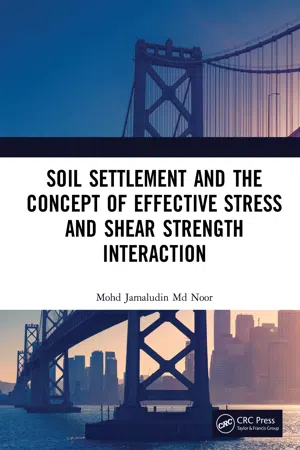
Soil Settlement and the Concept of Effective Stress and Shear Strength Interaction
- 238 pages
- English
- ePUB (mobile friendly)
- Available on iOS & Android
Soil Settlement and the Concept of Effective Stress and Shear Strength Interaction
About This Book
This book is about the principal concept of soil mechanics that become the basis in explaining the soil mechanical behaviours. It is the extended concept of effective stress of Terzaghi and it is known as "the concept of effective stress and shear strength interaction."
This new concept incorporates the role of mobilised shear strength developed within the soil body in resisting the compressive effect. Based on this new concept a comprehensive soil volume change framework has been developed known as Rotational Multiple Yield Surface Framework (RMYSF). This RMYSF is able to explain and quantify the puzzled and complex soil volume change behaviours. The main advantage of this RMYSF is that it is able to make a good prediction of soil and rock stress-strain responses at any effective stress. This will lead to accurate prediction of soil and rock settlements.
Due to its simplicity and the comprehensive nature of this new fundamental concept in soil and rock mechanics, it will eventually be included in soil and rock mechanics syllabus for undergraduate and postgraduate courses. This book would be very useful for geotechnical engineers dealing with soil settlement, underground excavation, computer modelling, rock mechanics, road engineering, earth and rock dam engineering and tunnel engineering.
Frequently asked questions
Information
Chapter 1
1.1 Introduction to soil stress–strain response and shear strength behaviour



- Stress–strain curves become steeper as the confining pressure increases.
- Axial strain at failure increases with the increase of the effective confining pressure. In other words, the axial strain at failure is not the same for each stress–strain curve. The maximum deviator stress occurs at different axial strains for each stress–strain curve.
- Maximum deviator stresses increase with the increase in the effective confining pressures.
- The responding strain is higher under the same increase in stress at a lower effective confining pressure. This will be further illustrated in the following paragraph.
Table of contents
- Cover
- Half Title
- Title Page
- Copyright Page
- Table of Contents
- Preface
- About the author
- 1 The true soil stress–strain response and shear strength behaviour
- 2 Concept of effective stress and shear strength interaction in governing soil settlement
- 3 Rotational Multiple Yield Surface Framework
- 4 Normalised Strain Rotational Multiple Yield Surface Framework
- 5 Modelling inundation settlement and loading collapse settlement using RMYSF
- 6 Anisotropic and elastic–plastic rock deformation model for accurate prediction of intact rock stress–strain response
- Index